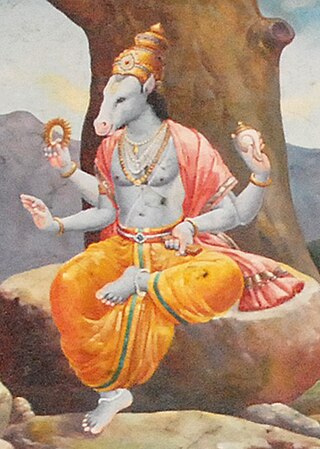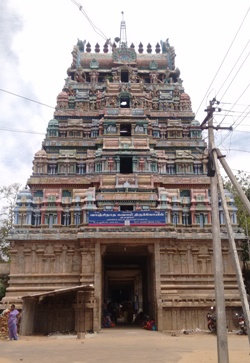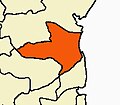
Nagapattinam is a town in the Indian state of Tamil Nadu and the administrative headquarters of Nagapattinam district. The town came to prominence during the period of Medieval Cholas and served as their important port for commerce and east-bound naval expeditions. The Chudamani Vihara in Nagapattinam constructed by the Srivijayan king Sri Mara Vijayattungavarman of the Sailendra dynasty with the help of Rajaraja Chola I was an important Buddhist structure in those times. Nagapattinam was settled by the Portuguese and, later, the Dutch under whom it served as the capital of Dutch Coromandel from 1660 to 1781. In November 1781, the town was conquered by the British East India Company. It served as the capital of Tanjore district from 1799 to 1845 under Madras Presidency of the British. It continued to be a part of Thanjavur district in Independent India. In 1991, it was made the headquarters of the newly created Nagapattinam District. Nagapattinam is administered by a Special grade municipality covering an area of 17.92 km2 (6.92 sq mi) and had a population of 102,905 as of 2011.

Cuddalore, also spelt as Kadalur, is the city and headquarters of the Cuddalore District in the Indian state of Tamil Nadu. Situated south of Chennai, Cuddalore was an important city and port during the British Raj.

Hayagriva is a Hindu deity, the horse-headed avatar of Vishnu. The purpose of this incarnation was to slay a danava also named Hayagriva, who had the neck of a horse and the body of a human.

Nagapattinam district is one of the 38 districts of Tamil Nadu state in southern India. Nagapattinam district was carved out by bifurcating the erstwhile composite Thanjavur district on 19 October 1991. The town of Nagapattinam is the district headquarters.

Jagadguru Shri Chandrasekharendra Saraswati Mahaswamigal also known as the Sage of Kanchi or Mahaperiyavar was the 68th Jagadguru Shankaracharya of the Kanchi Kamakoti Peetham. Mahaperiyavar's discourses have been recorded in a Tamil book titled "Deivathin Kural".

Dakshinamurti is an aspect of the Hindu god Shiva as a guru (teacher). He is regarded to be the personification of the supreme or the ultimate awareness, understanding, and knowledge. Dakshinamurti represents Shiva as a teacher of yoga, music, and wisdom, offering an exposition of the Shastras. He is worshipped as the god of wisdom and meditation.

Cuddalore District is one of the 38 districts in the state of Tamil Nadu in India.

Vaitheeswaran Koil is a Hindu temple dedicated to the Shiva, located in the Indian state of Tamil Nadu. Shiva is worshipped as Vaidyanathar or Vaitheeswaran meaning the "God of healing" and it is believed that prayers to Vaitheeswaran can cure diseases. Vaitheeswaran is a Tamil derivative from vaidya (Doctor) and Ishvara (God/Master). The presiding deity is Sri vaidyanathan, facing towards West whereas East side is the common one. He is the God of Healing. When pronouncing in Tamil, it sounds like "vaideeswaran". It is one of the nine Navagraha temples and is associated with the planet Mars (Angaraka).

Vadalur is a Town and 2nd Grade Municipality in Cuddalore district, Tamil Nadu. It is 208 km (129 mi) from Chennai, the state capital of Tamil Nadu.
Thiruvarutprakasa Vallalār Chidambaram Ramalingam, also known as Vallalār, Ramalinga Swamigal and Ramalinga Adigal, was one of the known Tamil saints and a notable Tamil poet of the 19th century. He belongs to a line of Tamil saints known as "gnana siddhars".

Dharumapuram Aadheenam is a Saivite monastic institution based in the town of Mayiladuthurai, Tamil Nadu. As of 2019, there were a total of 27 Shiva temples under the control of the adheenam.

Pataleeswarar Temple is a Hindu shrine dedicated to Shiva in the town of Thirupathiripuliyur, Cuddalore. It was constructed during the Pallava and Medieval Chola periods.

Apatsahayesvarar Temple, Alangudi or Guru Sthalam or Tiru Irum Poolai is a Hindu temple dedicated to Shiva located in the village of Alangudi in the Valangaiman taluk of Tiruvarur district, Tamil Nadu, India. Shiva is worshipped as Apathsahyesvarar, and is represented by the lingam. His consort Parvati is depicted as Elavarkuzhali. The presiding deity is revered in the 7th century Tamil Saiva canonical work, the Tevaram, written by Tamil saint poets known as the Nayanmars and classified as Paadal Petra Sthalam.
Aranthangi Fort is a fortress situated in the town of Aranthangi in Pudukkottai district, Tamil Nadu, India. It was constructed in the 16th or 17th century AD by Tondaiman kings. Nearby, there is an 11th-century Hindu temple constructed by Rajendra Chola.

The Pancha Bhuta Sthalam refers to five temples dedicated to Shiva, each representing a manifestation of the five prime elements of nature: earth, water, fire, air, and ether. Pancha indicates "five," Bhuta means "elements," and Sthala means "place." The temples are located in South India, four in Tamil Nadu and one in Andhra Pradesh. The five elements are believed to be enshrined in the five lingams of the temples, with each lingam named on the element represented. All five temples are located around the 78°E and 79°E longitudes and between 10°N and 14°N latitudes.
The Subrahmanya Temple is a Hindu temple dedicated to Murugan located in the town of Perambur, 14 kilometres from Mayiladuthurai. The principal idol of Murugan has six faces. There are plenty of snakes that occupy the precincts of the temple.

Vanchinadha Swamy temple is a Hindu temple dedicated to the deity Shiva, located in Srivanchiyam, Tiruvarur District, Tamil Nadu, India. Shiva is worshiped as Vanchinadha Swamy, and is represented by the lingam. His consort Parvati is depicted as Mangalambigai Amman. The presiding deity is revered in the 7th century Tamil Saiva canonical work, the Tevaram, written by Tamil saint poets known as the Nayanmars and classified as Paadal Petra Sthalam.

The Tirucherai Sivasthalam is a Tevara sthalam located in the village of Tirucherai near Kudavasal in Tiruvarur district, Tamil Nadu, India. The Sivasthalam encloses a Gnanaparameswarar Temple, in which the presiding deity is the Hindu god Shiva. Nayanmars Appar and Campantar have sung in praise of the deity.
Koothanur is a town situated in the Tiruvarur district of Tamil Nadu, India. The town is located at a distance of 25 kilometres from Tiruvarur. A temple for Saraswati, the Hindu goddess of learning is situated in this place. Koothanur is the only temple in Tamil Nadu for the goddess Saraswati. Saraswati is considered as the goddess of knowledge so people believe that if they worship this deity they will become good in knowledge.
Sivaganga Palace is a palace in Sivaganga district, Tamil Nadu, southern India, about 40 kilometres (25 mi) from Madurai. It is an old royal palace, with many historical connections. The palace was used as residence by queens Velu Nachiyar (1780–90), Vellacci Nachiyar (1790–93) and Rani Kaathama Nachiar (1864–77). No remains of the original Sivaganga Palace exist, but a new palace, known as "Gowri Vilasam", was built by Padamathur Gowry Vallabha Thevar (1801-1829) in the year 19th century. A heritage site of Chettinad, it was the property of Rani Velu Nachiar.
















